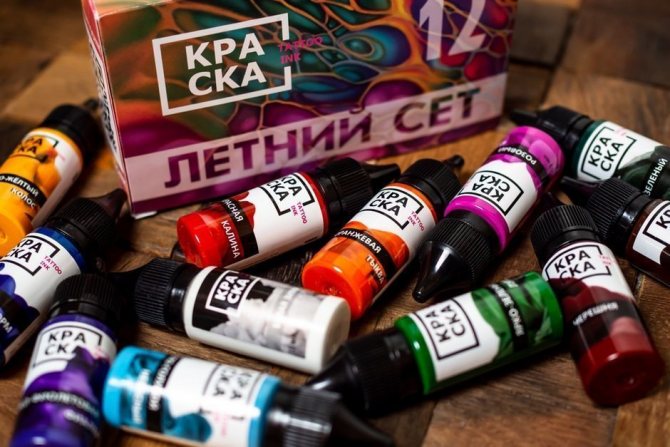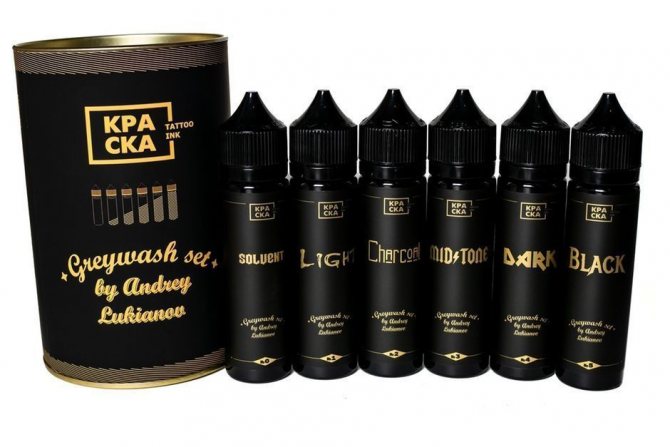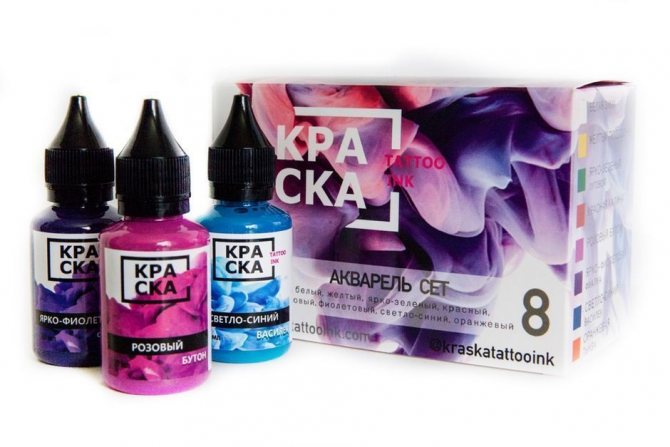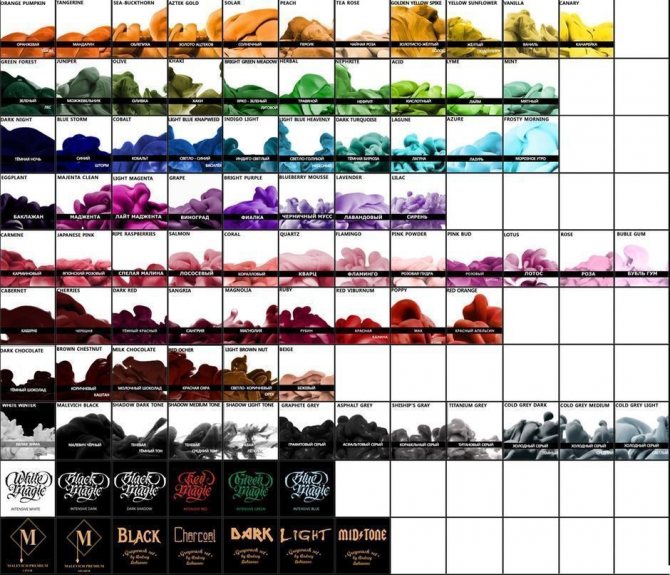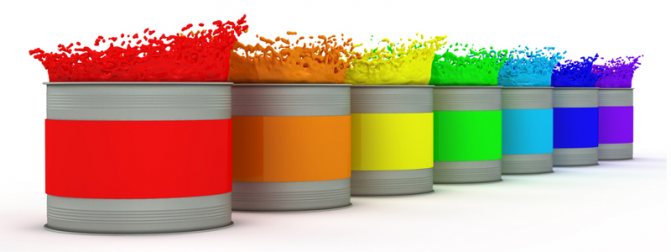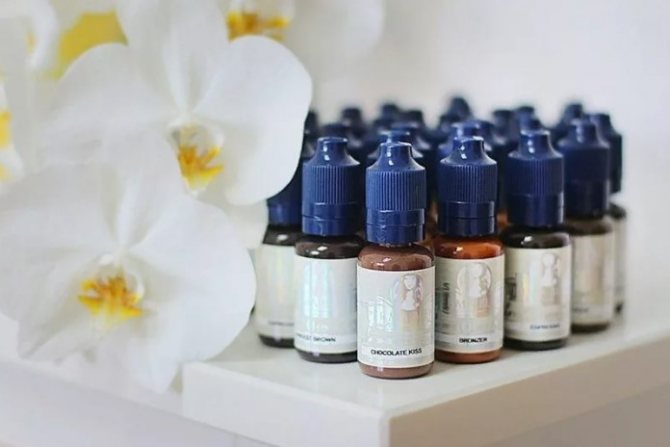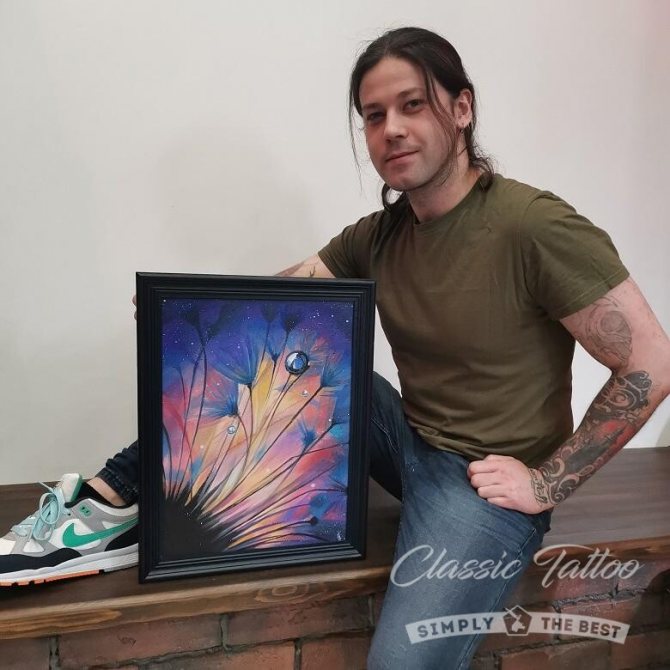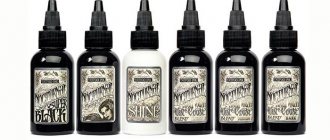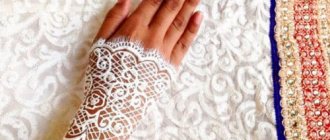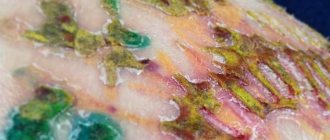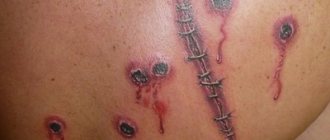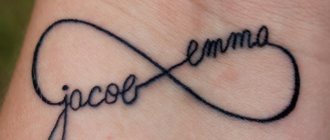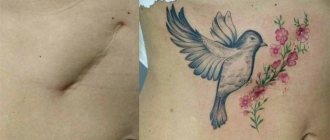All you need to know about expiration dates and storage regulations for tattoo pigments.
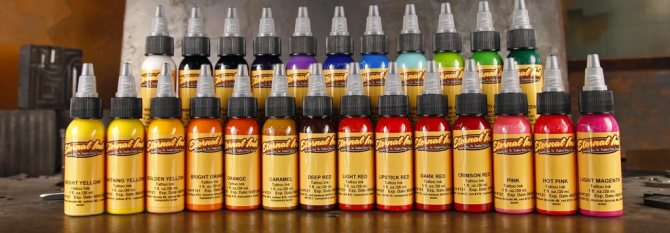
We value our reputation and before we ship your order ALWAYS We ALWAYS check the expirationiration dates:
- 1/2 oz. tattoo pigments have a shelf life It is more than three months.
; - For 1 oz. tattoo pigments, it's over four months.
;
Yes, we have tattoo paint with a shorter shelf life. It is sold in our DISCLOSURE section at a discounted price. Its "expiration date" is listed in the description.
So what is the "expiration date" of tattoo paint?
The answer to this question is perceived by many people ambiguously. With foodstuffs, for example, everything is transparent: milk is unfit for consumption when it expires. The situation is different with pigments.
Most pigments consist of a dye and a carrier fluid. Inorganic dyes have no expiration date. The carrier fluid evaporates with time. Visually, it looks like the ink is delaminating. This does not affect the quality of the ink in any way. It is enough to shake them.
If the bottle has been opened or the sealing has deteriorated due to improper storage conditions, the carrier fluid may evaporate and the pigment will dry out. So, the "expiration date" or "Exp. Date" indicated by the manufacturer on the packaging is the average period of time during which under the conditions of storage
The pigment remains in its original condition. If the storage conditions are not met, the ink may dry out much sooner than the expiration date.
Whether or not to use the ink after the expiration date is up to you. The economic situation is such that sale prices help many people, even though the quality of the pigments does not change. This is everyone's personal choice.
How to store tattoo pigments correctly?
Pigments necessary to store:
- In a dry place;
- In a room temperature;
- Away from direct sunlight.
In our store the storage conditions are strictly adhered to. That and you are advised! Thank you for your attention.
This article is a collection and edited the most relevant material taken from the network and the experience of some masters. Will be supplemented and edited as information becomes available.
Tattoo ink is a special coloring pigment that is used by tattoo artists to apply designs to the skin. The inks, which often include oxides of various metals, mix well together to form new shades of color. The main requirements for coloring pigments include their purity and high dispersity.
Tattooing technology over the centuries of history of this art has undergone many changes. This applies not only to dyes, but also to the tools used to make tattoos and even the technique itself. Initially for the application of tattoos used animal and fish bones, prickles of various plants. Some types of ethnic tattoos involved not only the introduction of paint under the skin, but also carving drawings on the body, which was closer to what we now call scarring.
Tattoo inks were also made from plants and were naturally inferior to modern pigments in a number of ways: they caused severe allergic reactions and were less resistant to time. The development of the chemical industry had a serious impact on the quality of tattoo inks. Dyes injected under the skin are now carefully treated. The high degree of purity of the dye pigment subjected to oxygen treatment contributes to quick healing and durability of the tattoo. One of the best and most expensive at the moment are considered paints consisting of surgical plastic microgranules, they have saturation of color and durability.
Mineral, organic and vegetable pigments are commonly used for micropigmentation. Mineral pigments are the latest technology in the field of tattooing (permanent make-up). They are characterized by high stability - this means that the coloring substance almost does not interact with the lymphatic or fat cells. Thanks to this property, there is no pigment migration - the pattern does not "blur" under the skin. Mineral pigments are economical because of their thick consistency. For the most part, these colors consist of pure and sterile zinc and iron oxides. The usual base of organic and vegetable pigments is barium sulfate, such paints are very rare and little used. Their use is undesirable because they are poorly soluble due to their origin, and this can lead to pigment migration. In addition, vegetable pigments change their color faster when exposed to light.
There has been little change in the development of tattooing techniques over the millennia. Only with the development of the seafaring era and European expansion to other continents there were serious changes. From the 17th century begins the active development of tattoo art in Japan and Europe. Exactly the technique of the Japanese tattoo masters became one of the most perfect, what remains to this day.
Over a question "what color it is better to work" thrash thousands of tattooists, constant experiments with different pigments allow you to choose the best, only so and no other way. Today's stores sell mostly only paints that thousands of people work with, so it's impossible to give preference to a particular company.
Modern paints for tattoos are available for coloring and outline (with label "line"). For example for black and white tattoo (black & grey) use special sets of black paint (grey wash for shading, in common parlance "greivosh"), mixed with distilled water in certain proportions to get the necessary tone.
In our Internet store STARTATOO people buy the paint both experienced and beginners masters of tattooing.
If the first ones know exactly what to buy and how much they need, the latter often ask questions before they buy.
What does tattoo paint consist of
The purchase of quality paint for tattoos is the basis of a long-lasting drawing on the body.
So how do you know if the paint is quality? First, let's understand what it consists of.
All paint consists of a base and a coloring pigment.
The base - is synthetic substances: distilled water, alcohol, synthetic glycerin, synthetic resins, propylene glycol, polyethylene glycol - 400.
Pigments included in the paint consist of organic and inorganic substances.
| Black | These are technical carbons: iron oxides, tar and wood resin. |
| White | It is based on lead carbonate, titanium dioxide and zinc oxide. |
| Gray | There are no separate dyes. Shades are obtained by mixing technical carbons and titanium dioxide (black + white). |
| Red | Includes cinnabar, cadmium selenide or mercury sulfide. |
| Yellow | It is based on cadmium sulfide. |
| Blue | It is composed of cobalt. |
The other colors are obtained by blending these pigments.
At first glance it may seem that these are not safe compositions, but if you look into it - all the components are harmless. All of these are used in cosmetics and in the food industry on a daily basis.
The substances that make up tattoo pigments are solid and insoluble in water. In order to create a pigment in the desired form, it is mixed with the base.
Application of pigments
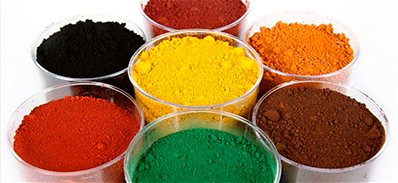

Pigments have found widespread use in the paint industry. They are used to make this or that paint get the desired shade. Depending on their use, the paint can become more intense in shade and dense.
Warning: A paint product will have a more dense finish if the refractive index of the pigment is higher than the refractive index of the substance that forms the film.
The addition of pigments to paint products plays an important role in the production of all kinds of paints. They give them certain properties, such as resistance to corrosion and resistance to environmental conditions. Together with pigments various fillers are added to give certain characteristics to paintwork materials.
Today pigments are used not only in the paint industry, but also in cosmetics. They provide the opportunity to obtain shadows, lipsticks and many other cosmetic products of saturated shades, with which you can create makeup and express your personality.
Production of tattoo paints
Special and very expensive equipment is used for mixing: a large amount of energy is spent.
The machine mixes the substances at the molecular level, after which the paint remains stable and the layering process takes many years.
As you can see, it takes a huge amount of resources, both human and energy, to create a finished product.
The main rule of buying quality paint is price.
Paint cannot cost cheap - this is a reason to think about its quality, and as a consequence - its reputation. The average price of a quality tattoo paint of 15 ml - 300-500 rubles. Go to directory of tattoo paints
Functions of pigments
Now let's talk about replenishing pigments, as well as what are filling and cheapening elements. After all, they all together carry the quality of the material is the same, but the cost becomes much lower.
Such substances are used for the greatest number of elements and material. They are something that is included in almost all modern paints to achieve the desired goals. Since such pigments are the most inexpensive, along with the pigments we discussed above, auxiliary pigments are used to achieve the desired effect.
In particular, you may want to create a pastel color. The main pigment used for this purpose is titanium dioxide. This is how an emulsion paint of white color is obtained. But this element cannot give the paint a matte finish. In addition, it was not invented for this purpose. Therefore, special particles are used that are a bit coarse dispersed. For example, they take calcium carbonate. When it is combined with the specified pigment, it achieves a whiteness of matte quality, which cannot be obtained from the usual basic pigment.
Such a matte color can be used for primers, for intermediate layers. It is usually used for painting cars. After such coating, which can not be the main one, the glossy one is still used. Whatever the case may be, auxiliary pigments do not only contribute to the cheapness of the paint, but also to the additional qualities of the substances.
Usually such elements are colorless. And it is the colorless auxiliary pigments that are chosen to be added to an existing color. Usually their sizes are small. They range from a fraction to a dozen microns. The refraction comes out along with the binder in which the auxiliary pigment is included. This means that it is difficult to cover a surface with this kind of material. It is for this reason that refinishing additives cannot be used on their own, but only as an additive.
If the additive is done as a plate type, it can protect the surface from water. The material becomes watertight. And this means that such substances can be used as an anti-corrosion coating. You can take talc, which is often used in cars when coating them. In this way, you can achieve relief in sanding the coating, which should be done before the last coat is applied.


Usually the thickening additive is extracted directly from natural materials. Therefore, they require pre-cleaning. It all depends on what purpose is pursued when using auxiliary pigments. It is true that they do not have certain stable properties that the main pigment has. Therefore, the composition of the particles, their size and dispersion may change.
Synthetic substances that are polymer-based fillers are often used. They can be in the form of beads, which have a diameter of up to thirty micrometers. Inside each bead there is air, the size of each bead is sub-micron in general. However, such fillers turned out to be too expensive, so they were not widely used. No one would just buy them. But if there is a specific purpose in using this substance, then you can use these polymer balls.
Table 2. Application in pigments of additives.
Chemical Composition Provenance Types
| Barium sulfate | Barite |
| Calcium carbonate | Chalk, calcium |
| Calcium sulfate | Gypsum, anhydrite, precipitated calcium sulfate |
| Silicates | Silica (silica), clay, talc, mica |
Tips for novice tattoo artist on the choice of paint
- Choose trusted manufacturers as bright, saturated colors can be received only if high-quality colours are used. The stingy pays twice, and the stingy artist pays with his reputation.
- Black pigment runs out faster - feel free to take a large volume.
- Paints often dry out, so keep the thinner handy.
- If you are still undecided about your technique and style - try the ready-made kits, such as Summer Set from KRASKA tattoo ink. The set contains 12 colors in 15 ml each.
Our customers prefer World Famous Tattoo Ink, Eternal Ink or Tatoo Ink.
You can be sure of a great result by choosing these brands.
World Famous Tattoo Ink
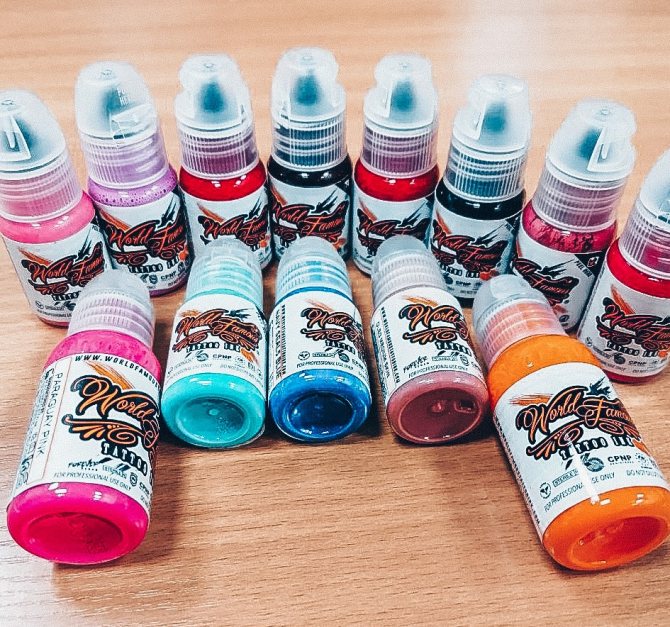

World Famous Tattoo Ink are some of the best on the world market. Most famous tattoo artists create their works with these very tattoo inks. Dense, thick pigment of the highest quality is presented in a wide color palette.
Choosing this brand paint, you get more contrast, bold, bright and high-quality work. This is what distinguishes World Famous Tattoo Ink.
In our store we have a variety of sets as well as 15 and 30 ml bottles.
Tattoo Ink
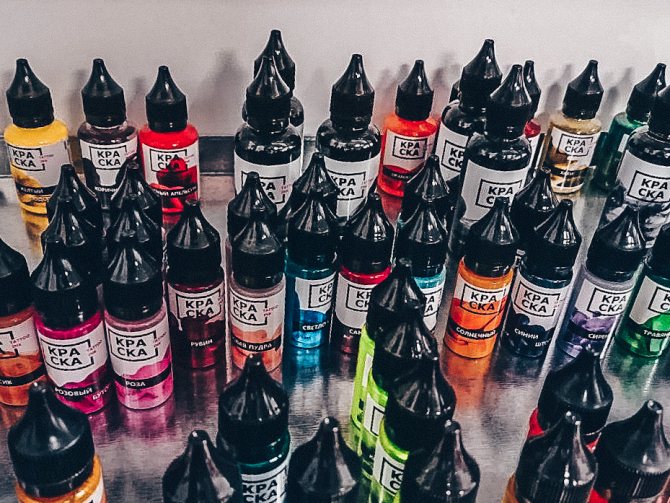

Our Russian brand Tattoo Ink has already earned the respect and love of many tattoo artists.
The manufacturers, with a team of professional chemists and tattoo artists, conducted a detailed analysis of the top tattoo paints and developed a unique formulation that includes the best and most modern ingredients.
We have a variety of kits in our store, as well as 15, 30 ml bottles.
Eternal Ink
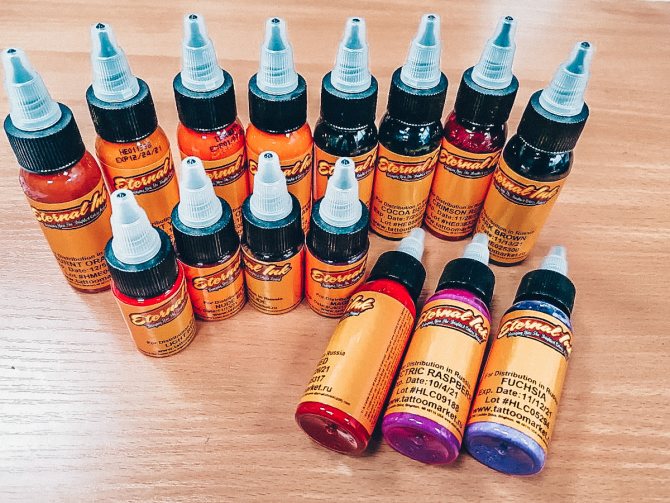

Tattoo ink created by artisans for artisans.
Eternal Ink needs no advertising. This is the world standard of tattoo ink.
Consistency of quality and color - the characteristic difference of this paint. Creators understand how it is critical for tattoo master, that's why they create such product.
In our store you can find 15 and 30 ml. bottles.
In the store STARTATOO STARTATOO shop presents only high quality products of world-famous brands. Experienced consultants will be happy to help you with your choice. Delivery and self-delivery is carried out to all regions of the Russian Federation.
The full range of our store will always delight you with the availability of tattoo paints in any shades and volumes.
What is the difference between permant and tattoo paints?
PERMANENT COLORS used in most city salons, have the following properties: 1. Their shelf life is not more than 3 months, after this time you need to reapply, and now imagine that the delicate skin of your eyelids or lips once every three months stitched with a sewing machine. 2. Permanent dyes change color over time! Your eyebrows get a red tint, and the arrows on your eyes get blue-green (the color of a prison tattoo), of course after such changes you need either reapplication or full reduction. 3. This paint doesn't come off well with a laser, which means that if you decide to get rid of faded red eyebrows or prison tattoo arrows, you'll probably only be able to do it partially, or maybe not at all. These features of the paint are undoubtedly very profitable for salons working with it, because the faster the paint fades, the sooner you'll come to renew it and pay in full for a repeat session.
What to look for when storing pigments?
In addition to the fact that the pigment must be properly selected in relation to the coloring, it is important to monitor its condition, conditions and storage time. Only together, these factors will lead to a fruitful, painless healed and beautiful "output".
Expiration date of pigments
Paints are not the cheapest thing, and good paints are even less so. This is why, especially for people who put the material (money, profit) issue above the interest of the client, the following situation happens. An ink that is used in small quantities as a corrector, for example, with a green tint to block out redness, is past its expiration date. And a third or even half of the bottle is left. The consistency of the paint has not changed a bit, the color has not lost either. And the master, not wanting to waste money, continues to use it. This is fundamentally wrong.
Someone may argue with this, having many years of experience with different paints, able to distinguish the quality of the product by eye. But you should understand that the expiration date of the product is specified for a reason. By conducting experiments and analyzing them in production, it was found that after a certain period of time a particular component loses its properties. And nothing is known about its further behavior in human skin.
If we make an analogy with food, some people feel great after stale milk, while others suffer from severe poisoning. It's the same with paints; it's hard to foresee a reaction. This means that the responsibility is on the shoulders of professionals who understand that not only a person's health is at stake, but also their own reputation. So is it worth the risk?
Storage conditions for pigments
In the salon/office there must be a special place for the storage of pigments. It should be a rack, shelf or cabinet, protected from direct sunlight, big enough to prevent the bottles from falling down. It should be remembered that there should be no extraneous things or tools on the workbench during the procedure. The same rule applies to paints, even if they are used in a given session.
The master must prepare the pigment in the right amount (for example, in caps or capsules) and put the paint away. If it is necessary to add it during the procedure, it is necessary to remove or change gloves, perform the manipulation and return the vial back. If this is not observed, cross-contamination may occur, by smearing the same vial in the client's lymph externally. In addition, the pigments should not interfere with the cleaning of the work surface.
How to choose the paint for a tattoo
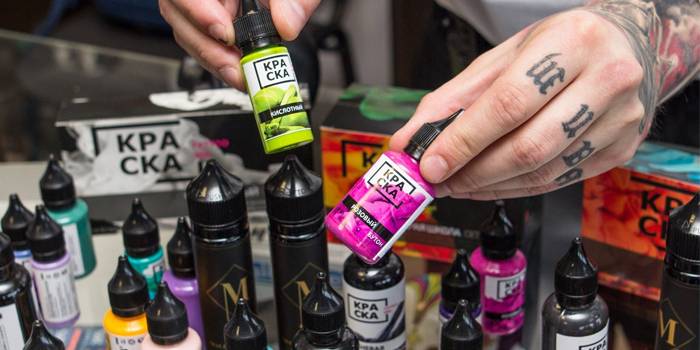

Pay attention to the variety of pigments:
- Inorganic. Such compositions are made from oxides, metal dioxides. Often artificial substances are diluted with organics - soot, turmeric, ochre, to get a wider palette of colors. When choosing an inorganic dye, remember that it is harmful to health and can cause allergic reactions.
- Organic. This category includes soot, iron and chromium oxides, ochre, turmeric - environmentally friendly substances that are completely safe for health. Shades can be both saturated and muted. The only disadvantage of organic pigments - they do not grind well, which makes it difficult to get a uniform color.
- Diluents. These include ethyl alcohol, water, listerine, propylene glycol, glycerin, sorbitol. Diluents increase the viscosity of the final product, help it to spread better in the skin layers. It is not recommended to choose a paint with high alcohol content, otherwise it will cause skin irritation. Masters often use sorbitol as a solvent which is similar to glycerin, but unlike it helps to obtain a high concentration of dye. It does not form a greasy film, which prevents deep penetration of the composition.
- Additives. This category includes thickeners, preservatives. They are used to decrease viscosity and prolong the shelf life of the paint.
Self-mixing paints lack necessary sterility that leads to all kinds of infections. In addition, the homemade composition does not keep for a long time. Using an expired product provokes irritations and other allergic reactions. When self-mixing all the substances are added "by eye", the paint is of poor quality, viscous or blurred on the skin.
Radiant colors
Paint - a worthy alternative to Fusion, and is also made in the U.S. (California). The company also cooperates with tattoo artists and is aimed at improving the components of paints. And it can be felt in their work!
All sets of this manufacturer that I used, showed the best way, but the red pigments like Scarlet Red - this is something. Radiant colors are called radiant, diamond colors for a reason. The colors are easy to apply, do not split and keep their original brightness on the skin even after the complete healing of the tattoo. And Radiant heals great.
The bottles are also handy: sturdy and flexible. And the ball inside for shaking the paint doesn't prevent it from flowing out of the container (as some manufacturers do).
The only disadvantage of dyes is that they are sparse, but not critical. It is comfortable to make a tattoo.
Organic dyes
Plant compositions are characterized by high cost, short life. "Wears" the tattoo about a year, then begins to fade. In addition, organic pigments are not fully soluble, so after the drawing can be blurred. The sun often changes the color of the paint to its original color.
Nocturnal Tattoo Ink (30ml)
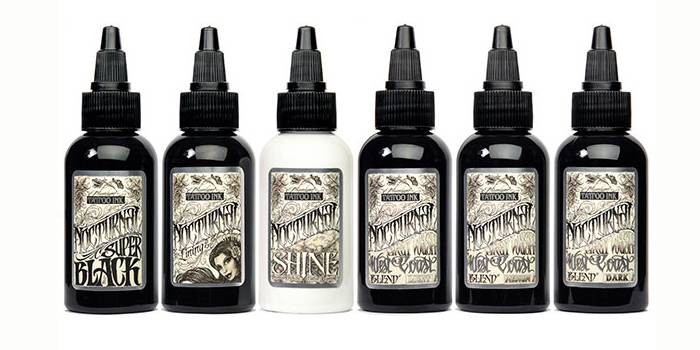

This ink is perfect to create any type of lines and shadows, portrait work. The dye is 100% made of organic pigments, contains no harmful substances, acrylics, polymers or other solvents. The mixture is of optimal density, it goes smoothly under the skin while creating tattoos without any effort.
Shake the bottle well before use. The universal ink, velvet black and gloss white shades are particularly popular among craftsmen. The colors are sold separately or in sets - for example, there is a set of dark and light gray paints. The product can be bought in bottles of 30, 60, 120, 240 ml.
Price:
Advantages:
- rich color;
- can be used for outlines and backgrounds;
- Drawing looks bright and clear;
- helps to get a realistic tattoo;
- Wounds heal quickly after use.
Disadvantages:
- Causes allergies on sensitive skin.
Eternal Ink (15ml).


Formulations do not include acrylic and animal additives. The product retains the original color under the skin, promotes rapid healing of wounds. There are more than 150 unique shades in the palette, and the manufacturer regularly supplements the line with new dyes. They can be purchased separately (15, 30, 60, 120, 240 ml bottles) or in sets.
The paint should be hammered in very tightly, in bright light. During the process, blood is released and the skin becomes red, which can cause lacerations. To avoid this, it is important to wipe the treated area frequently with tissues. If there are still gaps, it is possible to correct the pattern. The pigment will be more saturated and clear.
Price:
Advantages:
- large palette of colors;
- Optimal consistency for filling;
- Suitable for realistic works;
- Hypoallergenic for skin;
- With healing and proper care the paint does not fall out;
- Tattoos do not fade over time;
- low consumption.
Disadvantages:
- Difficult for inexperienced masters to work with.
Intenze Tattoo Ink (15ml)
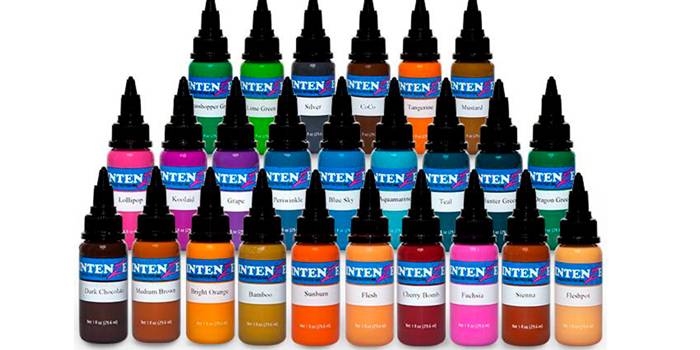

The best ink for tattoos has more than 250 shades in the palette - there are color and black and white pigments. They are sold in large and mini sets, individually. Available in 15, 30, 60 and 120 ml. The products are tested and absolutely safe.
Colored tattoo pigment is suitable for creating drawings of different styles. The consistency of the mixtures is not thick and not too liquid, so there are no problems with punching in. If necessary, the colors mix well with each other and with shades of other brands. Lines are smooth and bright from the first pass of the needle. Drawing does not lose its original appearance for many years.
Price:
Benefits:
- sealed bottles;
- huge palette;
- There are saturated and faded shades;
- Suitable for beginners or professionals;
- does not contain any animal products;
- promotes rapid healing of the skin;
- Does not cause allergic reactions;
- can be found in capsules for easy transport.
Disadvantages:
- Very thick ink;
- Short shelf life - 2 years.
The composition of the pigments
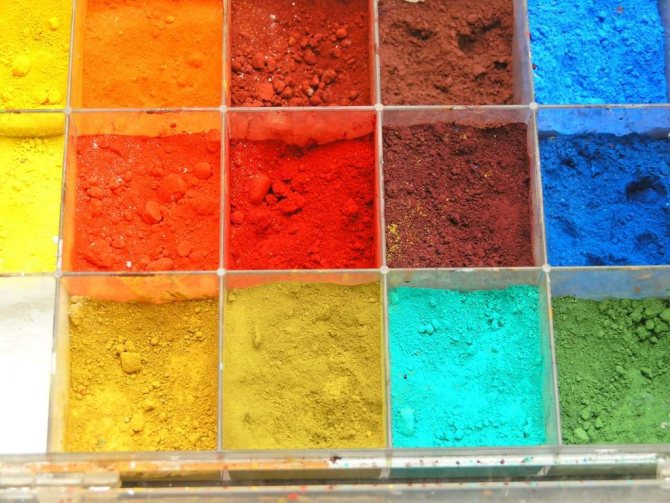

They usually look like microparticles of solid material. They are distributed in the total mass of the binder or film former. There are also auxiliary pigments. We will talk about them later. There are also additives that make the paint cheaper.
A real pigment can make a great contribution to the paint. Because it can give the paint element a valuable quality. It can give an anti-corrosive property as well as a positive quality to the coating. As for the cheapeners, they do not affect these qualities in any way. They only achieve a lower price, which allows the product to sell better. They can also affect the gloss, brightness, as well as facilitate sanding.
The main pigment is titanium dioxide.
Why is it exactly that? Because it allows you to achieve pastel or even white tones. After all, most interiors are precisely and such light colors, but not bright, which can be truly sporadic. The same quality of color is observed not only with apartment interiors, but also with cars.
Titanium dioxide usually refers only to high-quality pigments. Its rutile form is used. Refraction is us as an indicator at a high level. Dispersity and the size of microparticles are all calculated by its qualities. Titanium dioxide crystals are chemically inert, but have a photoactive property. In order to have the quality of photoactivity in a minimal manifestation, the property of coatings is applied, which helps to bring the photoactivity to a minimum. This is usually a binder pigment.
In addition to titanium dioxide, substances such as silicon dioxide as well as aluminum oxide are also used. Different ratios of these are used to achieve the right concentration so that the paint adheres perfectly to the surface. Since, due to them, the activity of photocells is reduced almost to zero, they contribute to the fact that the pigment becomes a binding link in the disperse variant.
Let us distinguish two types of disperse elements.
- Organic.
- Inorganic.
Earlier there were pigments that contained lead. These were the main three types of pigments. We are talking about:
- Chromates,
- Carbonates,
- Oxides.
In modern practice, such pigments have been abolished and are almost completely out of use. They are being replaced by safe pigments. However, this state of affairs leads to the fact that it is not always possible to achieve anti-corrosive properties and quality color with the pigment-substitute.
Paints for temporary tattoos
Drawings on the skin are created with the help of artificial pigments and henna. Under no circumstances should you use powders for hair coloring.
The shelf life of powders is about a year. To ensure that the henna retains its original qualities, place it in a sealed container.
ArtVio (10 ml)
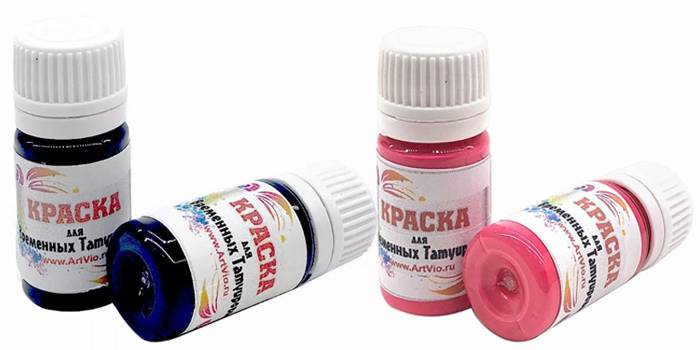

Temporary tattoo paint comes in handy little jars. It smells good, colors are bright and saturated, and stays on the skin. Compounds do not flow, even for beginners. Not too viscous consistency helps to accurately work out the smallest details of the pattern. It's better to use natural brushes and sticks. It is not allergenic. Drawing dries in 15-20 minutes, with careful care remains up to 10 days.
Price:
Advantages:
- hypoallergenic composition;
- semi-thick consistency;
- Lays on evenly, tightly;
- dries quickly;
- economical use.
Disadvantages:
Shankar henna in a cone (25 g)


The tattoo medium is sold in handy cones. It is completely ready to work - you only need to slightly trim the tip of the package. The mixture is squeezed out in small doses during the painting process, this ensures economical consumption.
The dye is safe, does not cause allergies. The color of the paste is black, it retains its brightness on the skin. The medium consistency helps to create thin lines on the body and completely covers large areas. Drawing dries for about 15 minutes, after which it is necessary to remove a thin film.
Price:
Benefits:
- natural composition;
- easy to use;
- helps to create bright drawings;
- it is convenient to make patterns, ornaments;
- dries quickly;
- Stays on the body for 4-7 days.
Disadvantages:
Neha henna in a cone (35 g)
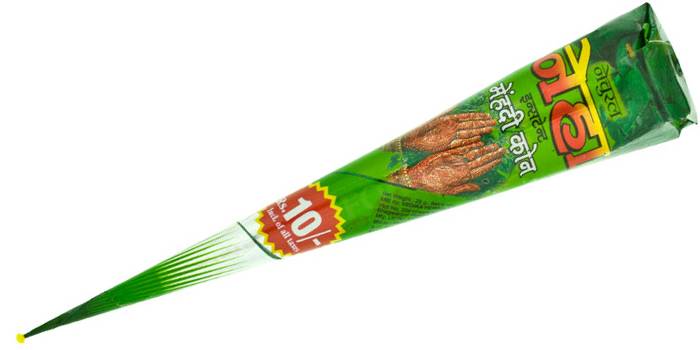

The Indian liquid henna is ready to use, you do not need to dilute it with water or tea. The cone-shaped packaging helps you create graceful ornaments on the body. The bio-tattoo dries quickly and lasts up to 3 weeks - time depends on skin type and care. To prolong the wear of the design, it is not recommended to rub with loofahs and soap.
Before using the henna, the corner of the cone does not need to be cut off, so there is no problem squeezing the product out. There is a protective needle at the tip, you need to take it out and you can start painting. If the drawing is done and the henna is left in the cone, close it again with a needle - so, the product will not leak out or dry out. A small amount of henna comes out during the drawing process, which helps create thin lines. Pressing hard on the cone produces a thicker outline.
Price:
Advantages:
- The cone is comfortable to hold in the hand;
- Suitable for beginners;
- It can be applied evenly;
- it does not spill out;
- does not cause allergies;
- the finished drawing is a dark brown shade;
- Long-lasting effect on the body.
Shelf life
Any cosmetic paints have a strictly limited period of application. Each manufacturer independently determines this interval. The more natural components, the shorter it is.
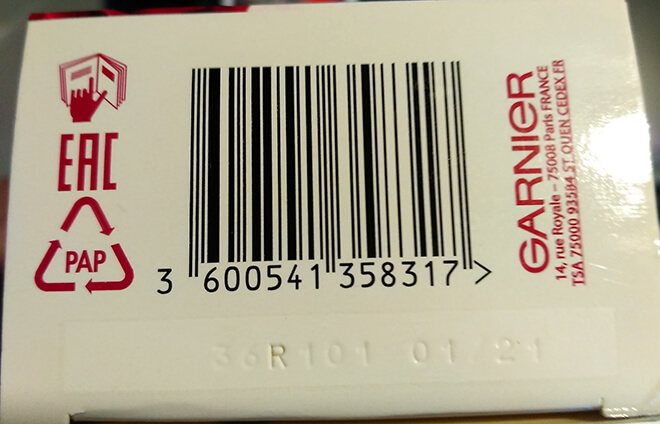

If you come across a specimen to be stored for many years, it is clear that the concentration of preservatives is at a maximum. In addition, the broken sealing of the package reduces the period of acceptable use many times.
For hair
When choosing, it is important to pay attention to the composition. The inclusion of manganese, iron, salts of heavy metals is undesirable. Vegetable oils, SPF-filters will have a beneficial effect on the condition of the hair. The expiration date is also important. It is usually three years.
Modern products have a creamy consistency. Having opened the original package, you should use the composition at once: the oxidation process begins immediately. In addition to the loss of basic qualities, it threatens health damage.
Water-based paints are sold as sprays. They are convenient to use, but the color lasts much less time.
For eyebrows.
Allowable period of use depends on the composition (natural ingredients deteriorate faster), as well as the structure:
- creamy;
- gel;
- permanent;
- liquid (capsules).
Closed ones are stored for up to 2 years. Dry, to be diluted, remain suitable for longer. Cream and gel consistencies are an excellent breeding ground for microorganisms, so you should use them several months in advance. Professional brands, such as Refectocil, make a product that is dilutable with an oxidant to a creamy consistency.
TIP! It is recommended to buy products designed for single use.
Nails
Acrylic paints are used for painting on the nails. They have bright, juicy, persistent colors thanks to quality components. Gel texture, environmentally resistant composition allows them to retain their properties for 3 years, even after opening.
It is important to close the tubes or palettes tightly after each use, keep them in a cool place, isolated from excessive heat, sunlight. After the allotted time, acrylic thickens and loses its brightness.
Tattoo
They are best used only by professionals. Otherwise you can get an unpleasant result. It will be difficult to get rid of it, because the tattoos are as long-lasting as possible.
They got this quality thanks to the pigment: it begins to fade slowly when the package is opened. Therefore, you can not use an expired product. It gets under the skin and can seriously harm your health. The period of use is about 3 years.
